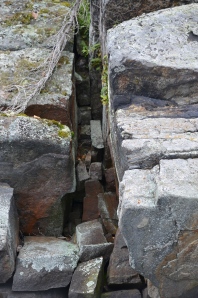 A furious battle is going on right now about whether a declining wolf population on (Michigan’s) Isle Royale National Park in Lake Superior warrants a helping hand from us human folks or whether nature should be allowed to take its course.
A furious battle is going on right now about whether a declining wolf population on (Michigan’s) Isle Royale National Park in Lake Superior warrants a helping hand from us human folks or whether nature should be allowed to take its course.
The intervention being considered would introduce some healthy wolves to an inbred population that has been devastated by a genetic deformity affecting their vertebrae. The “nature” that might be allowed to take its course has been compromised by climate change: our fault of course.
This dilemma came to light as a result of the Wolf-Moose Project, at fifty years old, the longest continuous study of a predator-prey system in the world. Several times, the study has been threatened with closing when it appeared that all that could be known had been captured. But then, having survived, it went on to uncover more mysteries, reach deeper depths of understanding, and turn up more insights into the highly complex links roughly characterized as predator prey relationships. Who knew moose ticks could play a part in the survival of wolf packs?
From the project’s excellent website, here’s what it’s uncovered: how wolves affect their prey, how population health is affected by inbreeding and genetics; what moose teeth can tell us about long term trends in air pollution; how ravens give wolves a reason to live in packs; why wolves don’t always eat all the food they kill; and the role of ticks.
Analyzing wolf scat, researchers were able to identify that in 1997, a large alpha male crossed over to the island via an ice bridge that lasted several weeks that winter, one of only two years in the previous 15 when Lake Superior had frozen sufficiently to allow this migration. He quickly took over a pack, forced another to extinction and grew his pack to 10 members, the largest in the previous 20 years.
But contrary to what the researchers first anticipated, the wolves survival rates did not increase. But digging deeper the scientists noticed that at the same time, the moose population had declined dramatically as a result of food shortages, a tick outbreak and a severe winter. The implication is that, had the food supply been in the normal range, the consequences of the alpha male’s arrival would have been more positive for the pack. The lesson: unrelated conditions can mask the beneficial effects of a widening of the gene pool.
More recently, these beneficial effects disappeared when his successful breeding eventually lead to all the wolves on the island being his descendants and the prevalence of genetic deformity in the vertebrae.
If we are ever to tackle the problem of when it is appropriate to intervene to save a species, we have to know these sorts of things. Even if knowing a little more leads to greater uncertainties.
From the Wolf-Moose Project website: “Every five-year period in the Isle Royale history has been different from every other five-year period—even after fifty years of close observation…and the next five decades will almost certainly be different from the first five decades…the most important events in the history of Isle Royale wolves have been essentially unpredictable events—disease, tick outbreaks, severe winters and immigrant wolves.”
If enlightened ignorance isn’t predictive, why are we bothering to study animal behaviour at all? Because it may stop us from committing more harm to the environment, plus it is absolutely fascinating.
For a description of what the fight to save the wolves is all about check out a story in the Detroit Free Times. http://www.freep.com/article/20131018/NEWS06/310180069/wolves-Isle-Royale
For a more gratifying understanding of the underlying issues in this complex story, check out the Wolf-Moose Project’s website. http://isleroyalewolf.org/overview/overview/at_a_glance.html
